What Is A Patient Portal? Top Benefits, Features, and Implementation Tips
If you’re a small practice owner who is searching for a patient portal in order to improve your patients’ experience and increase their engagement with your practice, we’re here to help you by going over benefits, features, and ways to make implementation as easy as possible.
Patient portals are no longer a “nice-to-have” software for your practice; they have become a necessity. Why? Due to lack of patient engagement, you’re losing out on potential revenue. It’s important to know that your patients will leave your practice to find a new one if they feel they aren’t getting the treatment and attention they deserve—and a patient portal helps resolve that.
We’ve surveyed patients in our Software Advice 2022 Patient Experience Survey [*] to get insight into how patients interact with and view portals to help inform the insights we provide you in this piece.
What is a patient portal?
A patient portal is a secure online website or application available either from a desktop, laptop, or mobile device that gives patients access to personal medical information or updates provided by their healthcare provider.
Why should you care about acquiring a patient portal?
According to our Software Advice 2022 Patient Experience Survey, 66% of patients expect their healthcare providers to utilize patient portals.

Not only do your patients expect their healthcare provider to utilize software tools such as patient portals, but they are less likely to choose your practice to begin with if you don’t have one in place.
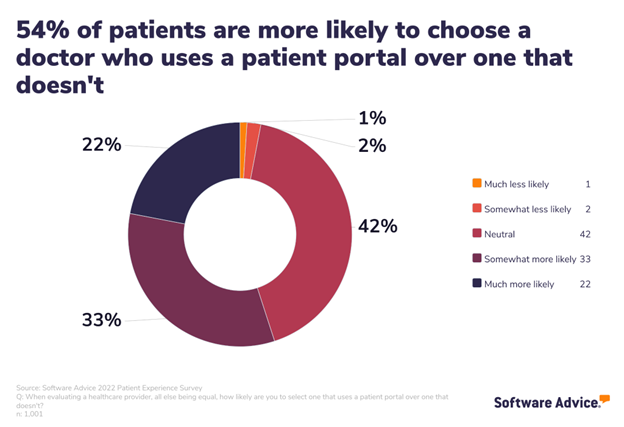
It makes sense too. A patient portal’s entire purpose is to help make your patient’s experience with their medical record, healthcare plans, and interactions with your practice as easy and simple as possible. Whether it’s paying their bill, communicating with you or your staff directly, receiving test results, or scheduling their next appointment, patient portals simply make your patients’ lives easier.
The four most important benefits of patient portals
The fact that this software is catching on so quickly reflects the unique advantages it brings. By and large, patients are interacting with their patient portals in four distinct ways that all go toward helping improve the patient experience:
Direct communication with their provider
Receiving test results
Paying their bills
Scheduling new appointments
It should be no surprise then that most of your patients expect these features of your patient portal to be easy to use.
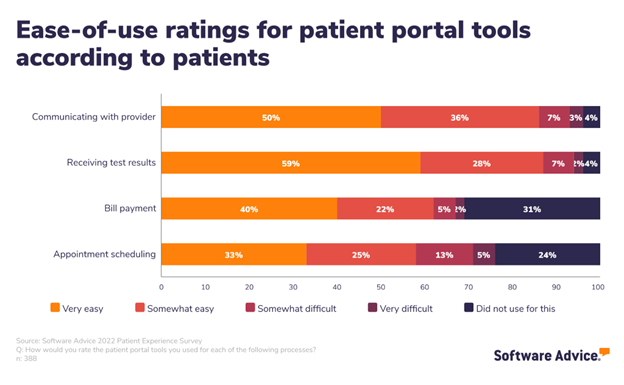
The good news is that most software providers who make patient portals know this and work to make the process of using these features easier by providing instructional documents for your patients, as well as you and your staff.
Read more here about patient experience and patient engagement:
Benefit #1: Communicating with their provider helps improve the patient experience
Patient portals are an important part of the patient experience because they allow your patients to communicate with you 24/7. This doesn’t mean you and your staff have to respond immediately, but it does give your patients the freedom to ask questions or bring up concerns whenever is most convenient to their schedule.
Dr. Rafi Salazar II [1], a Georgia-based healthcare consultant who has successfully focused on patient engagement and retention strategies, shares his thoughts about the importance of patient portals:
“The main incentive of using a patient portal is access to quick, secure, and individualized communication with their clinician or provider. Using secure messaging and other communication tools gives patients a level of access not commonly available until recently. Many patients are happy to use portals if they know they're getting access to clinicians.”
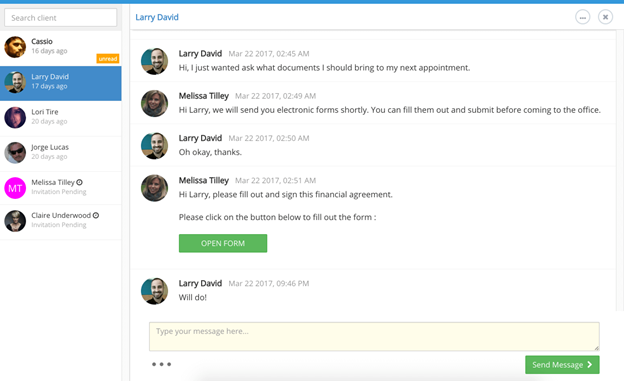
IntakeQ Software’s secure messaging via the patient portal (Source)
One important note here is to make it a habit of blocking time during your day to log into your patient portal app in order to respond to any communications you might have received. If you aren’t spending time responding to your patients, there is no point in even having that communication option to begin with.
Benefit #2: Receiving test results gives patients greater access and control over their personal health data
The benefit of your patients having complete access to their lab results and personal health records all in one easy-to-use place cannot be overstated. Patients who are engaged with their healthcare plans are more likely to stick to their medication schedule because they can see trends in their health data and test results all in one place.
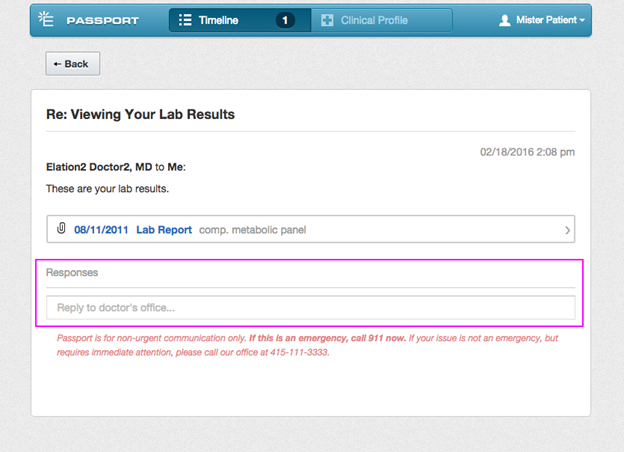
Elation Health EHR’s lab results page (Source)
When patients receive their test results manually, they are more likely to see them in the abstract because they look at them one time then file them away, never to be seen again, and they also don’t see the context of those test results against any past results. With patient portals, they have access to all of their healthcare data at one time.
It’s important for you and your staff to educate your patients about where they can find this data and the importance of it. Spend some time with your patients inside of the portal once they receive new test results to help them draw connections between their healthcare plan, the results, and any previous results they might have.
Benefit #3: Online bill paying through the patient portal means less missed payments
Online bill payments via patient portals are one of the most preferred ways for patients to pay their bills as well. An engaged patient who is utilizing their patient portal will be much more likely to pay their bills on time because they will see the outstanding payments highlighted in the portal.
Your staff won’t have to spend as much time tracking down late or missed payments which will free them up for more important tasks that can help your practice grow.
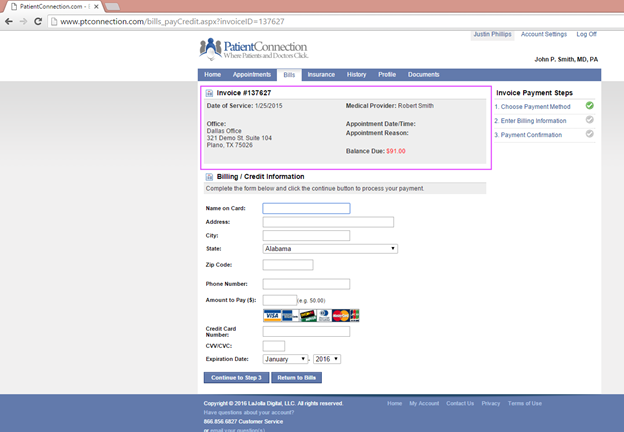
MDConnection’s billing options through the patient portal (Source)
Educate your patients about where they can go on the portal to pay their bills from the get-go. Either show them yourself, or have a dedicated member of your staff that is an expert in using your patient portal to run them through the entire process.
Benefit #4: Scheduling features save you and your staff time and money
Missed appointments are a huge deal for practices because it means less money coming in, and patients coming in late to their appointments means an overall negative experience for the patients who are on time for their appointments because it sets back every single appointment for the day.
That’s why the scheduling features in patient portals are so important. Not only can patients self-schedule their next appointments, but the portal will also send reminders to their preferred mode of contact whether that’s email, text, or an automated phone call. Additionally, patients can check the portal to see what time their upcoming appointments are at instead of calling the office which can distract your staff from other important tasks they might be doing at the time.

CORTICO’s patient scheduler (Source)
We may be sounding like a broken record here, but if you want your patients to use their portal, you need to advocate and educate. Train your staff to show any new patients how to schedule their appointments during intake, and if you are acquiring a new patient portal, make sure that every patient receives information and training about how to use it during their next appointment.
Other patient portal features you should know about
Once your practice is ready for patient portal software, break down must-have features and nice-to-have features so that you don’t waste time during your talks with prospective vendors.
For example: You may have an urgent need for online bill pay functions to expedite collections, but might not want to pay extra for automated appointment reminders.
Here are some of the most common and useful features available in patient portals:
Scheduling appointments online
Viewing health information (e.g., lab results or clinical notes)
Viewing bills/making payments
Checking prescription refills/requests
Filling out pre-visit forms (e.g., intake form)
Sending messages to my care (healthcare provider) team
Updating medical history
Evaluate your practice and what needs you need met in order to increase profitability. If you’re struggling with patient experience, you might want to focus on communication and scheduling features. If you need better claims collections? Look for billing features.
Once you have your must-have list of features, you can quickly look through vendors and separate them into two buckets:
Either they have the features you need and can continue being evaluated, or
They don’t have the features you need, and you can move on.
This helps your vendor search move much more quickly because you aren’t bogged down by looking through each one in detail.
How to select a patient portal
It’s very common for patient portals to be bundled into an integrated electronic health record (EHR) suite that includes additional medical software applications. Alternatively, practices can choose to purchase patient portal software as a stand-alone or integrated program. Here are the differences between the two types of systems:

Once you decide whether you want a stand-alone system or a suite, there are a number of steps you can take to select a vendor:
Research pricing and set a budget: Your budget will often dictate how robust you can expect your portal to be. Chat with our team of medical software advisors to get free advice on patient portals that fit your needs.
Compare product screenshots: It’s very important to pick a portal with a simple, yet effective, user interface. This way, your patients will feel comfortable logging on and navigating your system with minimal guidance.
Read detailed product reviews: If you like the look of a certain portal, make sure the functionality and customer support it offers are equally impressive. You can do this by checking out real user reviews for hundreds of patient portals on our website.
Shortlist five or six products: It can be tough to narrow down your options with so many systems out there. Feel free to fill out our online questionnaire to fast-track that process for free.
Contact the vendors on your short list: Once you have a manageable number of systems to evaluate, arrange personalized product demos with every vendor. This allows you to weigh the pros and cons of each with your team before choosing the perfect one.
Patient portal implementation advice
After you’ve decided on a specific product, you still have to make sure the implementation goes smoothly. Here are some best practices for introducing the technology into your workflow before sharing it with your patients:
Take advantage of the product’s training materials: Vendors offer a wealth of online educational materials that you can use to train your staff. These range from recorded webinars and instructional videos on YouTube to FAQ pages on the vendor’s website.
Designate a “super user” in your office: Most of your staff should be able to get by learning only the basic functions—but your practice should have at least one “super user” responsible for mastering the software. This will be the go-to person for fielding questions, requesting support from the vendor, and providing tips or shortcuts to the rest of your staff.
Create office-wide policies about when/how patient portal information is sent: You should be clear about who’s responsible for responding to patient portal queries, and how often they should do so. For example, perhaps the front office fields general portal queries every few hours, while nurses field clinical ones, such as follow-up care questions, as they come in.
Collect patients’ email addresses: Patients usually have to provide their email address to register for access to your portal. If you start collecting addresses early in the implementation process, you’ll be able to hit the ground running once the portal goes live. Consider modifying your pre-visit forms to include a section for patients to enter this information.
Set goals for your team: Determine specific objectives related to patient portal use at your practice. For example: Maybe your goal is to get 5% of your patients to access your portal in the next eight months, or for 10% to pay their bills online. Tracking goals will show whether the technology is serving its intended purpose, or if you need to change something in your workflow to encourage greater engagement from staff or patients.
Best practices for portal engagement
Even after you’ve done everything we’ve suggested for a smooth portal implementation, its success will ultimately come down to whether or not your patients actually use it.
Practices should choose a system with a user-friendly design and institute policies about responding to portal queries in a timely manner.
Here are some more tips to incentivize patient portal usage:
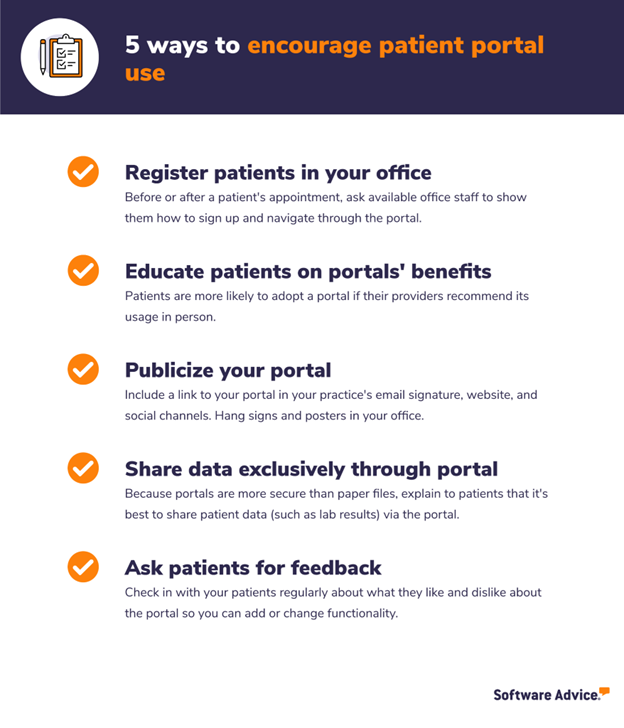
For more hands-on advice from an expert, read How To Increase Patient Portal Use by Educating Patients
Patient portals are necessary for any healthcare organization that wants to succeed
From improved communication to better scheduling options, patient portals offer you and your patients unique features that help you foster a better patient experience while also improving your efficiency as a business, so it’s a no-brainer that you need one to succeed.
If you know you need a patient portal but don’t know where to begin, you can start by talking to one of our software advisors. We’ll help you find the right software for your needs and budget in 15 minutes or less, for free. Schedule a call or click here to chat with a software advisor now.
Or, you can check out our New Medical Practice Checklist: How To Get Started.
Survey methodology
[*] Software Advice conducted the 2022 Patient Experience Survey in October, 2022 of 1,001 respondents to learn more about how patients view the experience they receive from their healthcare provider. Screening questions were used to narrow respondents to those with relevant experience with the subject matter